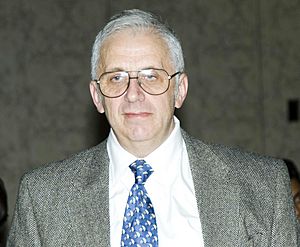Grigory Margulis facts for kids
Quick facts for kids
Grigory Margulis
|
|
|---|---|

Margulis on his 60th birthday, 2006
|
|
| Born | February 24, 1946 |
| Nationality | Russian, American |
| Education | Moscow State University (BS, MS, PhD) |
| Known for | Diophantine approximation Lie groups Superrigidity theorem Arithmeticity theorem Expander graphs Oppenheim conjecture |
| Awards | Fields Medal (1978) Lobachevsky Prize (1996) Wolf Prize (2005) Abel Prize (2020) |
| Scientific career | |
| Fields | Mathematics |
| Institutions | Yale University |
| Thesis | On some aspects of the theory of Anosov flows (1970) |
| Doctoral advisor | Yakov Sinai |
| Doctoral students | Emmanuel Breuillard Hee Oh |
Grigory Aleksandrovich Margulis (Russian: Григо́рий Алекса́ндрович Маргу́лис, born February 24, 1946) is a famous Russian-American mathematician. He is known for his important work on special mathematical structures called lattices and Lie groups. He also found new ways to use ideas from ergodic theory to solve problems in diophantine approximation.
Margulis has received many top awards in mathematics. He was given the Fields Medal in 1978, the Wolf Prize in Mathematics in 2005, and the Abel Prize in 2020. He is one of only a few mathematicians to win all three of these major prizes. Since 1991, he has been a professor at Yale University.
Contents
Early Life and Education
Grigory Margulis was born in Moscow, which was then part of the Soviet Union. His family was of Lithuanian Jewish descent. From a young age, he showed great talent in mathematics.
Math Olympiad Success
When he was just 16 years old in 1962, Margulis won a silver medal. This was at the International Mathematical Olympiad, a big competition for young math students from around the world.
University Studies
He went on to study at Moscow State University. In 1970, he earned his PhD. His research focused on a field called ergodic theory, which looks at how systems change over time. His advisor was the well-known mathematician Yakov Sinai.
Career and Achievements
Margulis's early work helped create important ideas in mathematics. He worked with another mathematician, David Kazhdan, on a key result about discrete groups. This is known as the Kazhdan–Margulis theorem.
Superrigidity Theorem
In 1975, Margulis developed his "superrigidity theorem." This theorem helped explain how certain mathematical groups are structured. It was a big step forward in understanding arithmetic groups within Lie groups.
International Recognition
Margulis was awarded the Fields Medal in 1978. This is often called the "Nobel Prize of mathematics." However, he was not allowed to travel from the Soviet Union to accept the award in person. Later, his situation improved, and he was able to travel more freely.
In 1991, Margulis moved to the United States. He accepted a position as a professor at Yale University.
Major Awards and Honors
Margulis has been recognized for his contributions to mathematics many times:
- In 2001, he became a member of the United States National Academy of Sciences.
- In 2005, he received the Wolf Prize in Mathematics. This award recognized his work on lattices and how they apply to many areas of math. These areas include ergodic theory, representation theory, number theory, and combinatorics.
- In 2012, he was named a fellow of the American Mathematical Society.
- In 2020, he shared the Abel Prize with Hillel Furstenberg. They received the award for being pioneers in using probability and dynamics in group theory, number theory, and combinatorics.
Key Mathematical Ideas
Margulis's work has had a huge impact on modern mathematics. He solved long-standing problems and opened up new areas of research.
Understanding Lattices
Much of his early work focused on understanding "lattices" in certain types of mathematical groups. He proved that many of these lattices, which are defined by their properties, are actually "arithmetic." This means they can be built in a specific, simpler way, similar to how you might think of matrices with only whole numbers. This discovery helped mathematicians classify these complex structures.
Solving the Oppenheim Conjecture
In 1986, Margulis completely solved the Oppenheim conjecture. This was a difficult problem about quadratic forms and diophantine approximation that had been unsolved for 50 years. His solution used new methods from group theory.
Expander Graphs
Margulis also created the first examples of what are called expander graphs. These are special types of networks that are very well-connected. They are important in computer science and other fields.
Images for kids
See also
 In Spanish: Grigori Margulis para niños
In Spanish: Grigori Margulis para niños


